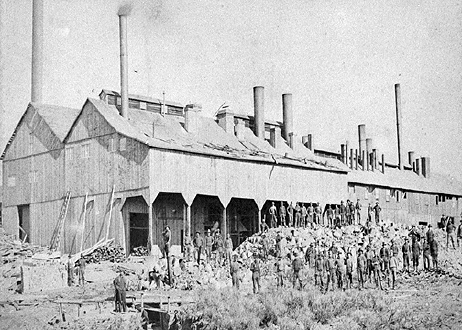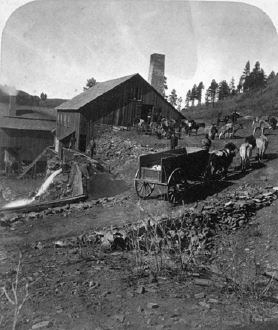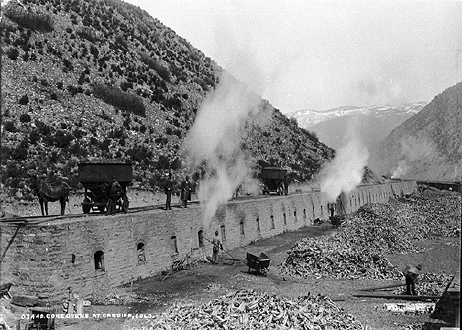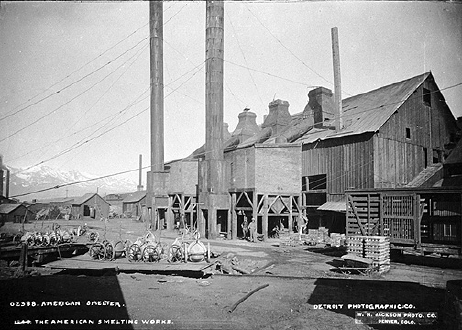Smelters
What do these photos tell you about how ores were smelted?
Grant Smelter At Leadville
The building is this photo is the Grant Smelter at Leadville. Smelters separated the gold and silver from the quartz rock hauled in from the mines.

Photo: Colorado Historical Society
More About This Topic
Miners had difficulty separating gold and silver from the quartz rock found deep inside a mountain. This ore contained sulfur and other minerals that also had to be removed. The process used to recover gold and silver from this ore was called smelting. Smelters like the one in this photo used hot blast furnaces to remove the gold or silver from the ore by melting it from crushed rock.
Their Own Words
"The smelter lies between the Rio Grande and Fort Worth [railroad] tracks, in the outskirts of the city [of Pueblo]. . . . The ore as it comes from the mines. . .is ground in powerful mills, which reduce it almost to powder. The only unusual noise in the place comes from these thundering crushers. . . . The [crushed] ore is kept in bins, from which it is taken to the roasting department. It is placed in furnaces here, sixty feet long and twenty wide, and is subjected to a low heat to rid it of sulphur. . .that may be in it. . . . Ore trucks, lifted in place by hydraulic elevators, next convey the roasted ore to the bedding floors, where it is fluxed for the smelters proper." "Bedding is, briefly, the mixing of ores and fluxes [limestone and other minerals]. . . .The mixing or bedding is accomplished by dumping the ores from the cars overhead, upon the bedding floors, where they are spread in thin layers, one above another until, maybe, the mass will be seven or eight feet deep. . . .
"The mixed ore, coke and limestone is thrown into the furnaces. . .from platforms above them. The openings for this purpose afford no view of the raging fires within, but they are there nevertheless, and the natural heat is intensified by a blast blown into them by one of two great engines. . . ." " On one side of them are the lead wells from which the workmen draw the molten metal in ladles, and pour it into moulds that hold about a hundred pounds each. The slag, or refuse, is run off on the other side. . . and pitched over the 'dump.'. . .When the moulds have cooled, bars having something of the sheen of silver, are taken from them, but it is not silver, at least not all of it. It is the "base bullion," in this instance more lead than anything else. It has yet to be refined, and for that purpose, in the case of this company, is sent to Philadelphia."
Source: Andrew Morrison, The City of Pueblo and State of Colorado (St. Louis: George Englehardt & Co. 1890): 117-118.
Silver Smelter At Windham
The building in this photo was a silver smelter at Windham, Colorado in Ouray County. The photo was taken about 1875. The burros and wagon are hauling ore to the smelter.

Photo: Denver Public Library, Western History Collection
More About This Topic
Every mining district had its smelters where miners brought their ore. The smelter in this photo must have served many small mines. Some of the miners brought their ore to the smelter by pack trains of burros.
Their Own Words
"Out in the smeltering works I saw long rows of vats, pans, covered by bubbling - boiling water, and filled with pure silver, four or five inches thick, many thousand dollars worth in a pan. The foreman who was showing me shoveled it carelessly up with a little wooden shovel, as one might toss beans."
Source: Description by Walt Whitman in Colorado: A Guide to the Highest State, (1940): 91.
Cake Ovens At Cardiff
This is a photo of the coke ovens at Cardiff, a town near Glenwood Springs. Coke is partly-burned coal used to heat the blast furnaces of smelters and steel mills. The men on the ground are putting wood into the ovens to burn the coal.

Photo: Colorado Historical Society
More About This Topic
The ore smelting business helped develop coal mining in Colorado. The smelters needed fuel for their blast furnaces. After cutting down the nearby forests for wood, the smelter owners began using coke. Coke is coal that is partly burned to remove impurities. The remaining coke burns much hotter than ordinary coal. The demand for coke made coal mining more profitable in Colorado.
Their Own Words
““El Moro . . . consists of four stores, one hotel . . . and about 300 population, most of whom are engaged in coal mining. . . . About six miles southeast of the town are located extensive coal mines, and about two miles in the same direction are 400 coking ovens. The coke produced here is . . . better than the celebrated ‘Connelsville’ [coking coal] of Pennsylvania, and is of a superior quality for use in the smelting furnaces, for which purpose it is shipped all over the state.”
George A. Crofutt, Crofutt’s Grip-Sack Guide of Colorado, (Omaha, Nebraska: Overland Publishing Company, Volume II, 1885): 89.
The American Smelter
The smelter in this photo was owned by the American Smelting and Refining Company. By 1900, it was the largest smelting company in Colorado.

Photo: Colorado Historical Society
More About This Topic
The buckets on wheels in this photo are called ladles. They were used to remove the melted silver from the blast furnaces. The metal was then poured into molds. In the molds the metal cooled and hardened into silver bullion. There is a stack of silver bars on the right side of this photo. Each bar weighed about 100 pounds.
Their Own Words
“The Argo smeltering furnaces are a group of buildings on the eastern outskirts of the city. Arriving at the works you take a short walk around a high broad fence, cross a track on which are freight cars laden with gold and silver ore and last arrive at the office door. Here you are likely to be challenged by a burly watch man who wants to know your business. If you are fortunate enough to know someone in the office you can gain admittance and a polite young man offers to take you over the works. First of all is the room where the ore is being ground into powder. This is necessary before the smelting and waiting processes begin."
“Here and there are heaps of powdered ore each pile marked with the name of the mine from which it has been taken. This ore is gray or brown or red in color and looks like any common powdered stone. Of course these mounds contain a great deal of precious metal. Seeing one which looked unusually rich, I asked our guide how much money he supposed was in ‘that.’ He looked queer for a minute and answered, 'That’s mostly brick dust.' Little half buckets carried off ores attached to a leather band which is constantly revolving over wheels carries the powdered ore to the furnace where the smelting process begins." “All of the slag sinks to the bottom of the furnace and at the end of a certain time is drawn off leaving only the metal, not yet, however, in the pure state.... "Still another smelting and wasting process follows this when the metal is ready for the tank. Here the almost purified metal is placed in huge tanks through which boiling water passes. The metal here is in its most beautiful form in quantities.... Not being yet in a convenient form the metal is removed from the tanks and melted. It is last of all poured into brick molds which contain about $1,000 worth of silver and which weigh when turned out about 85 lbs.”
Source: Henrietta Hitchcock Manuscripts, MSS#1344 Colorado Historical Society.

